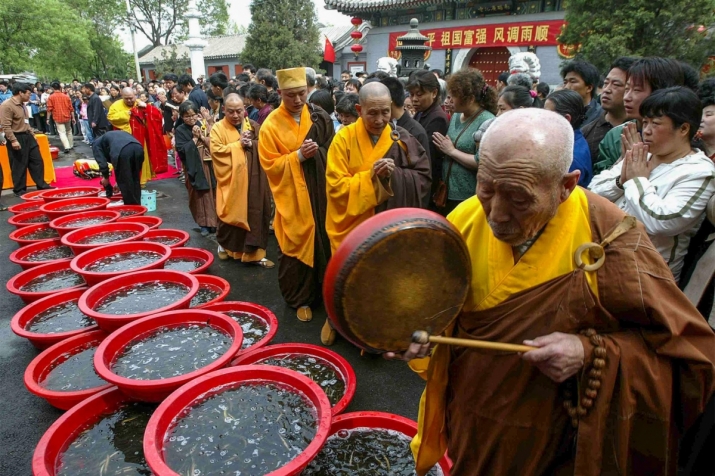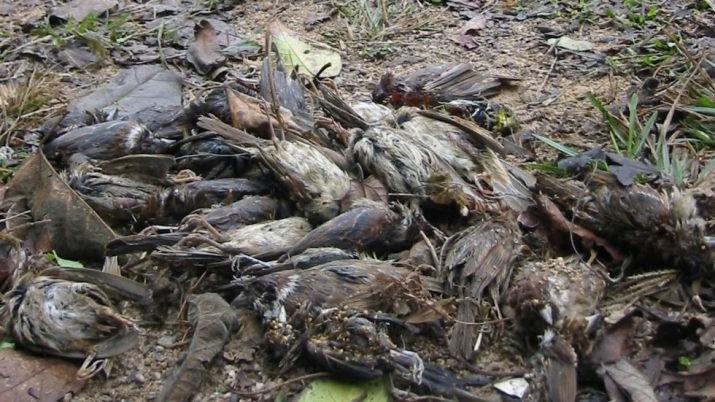NEWS
The Ugly Face of Life Release
 Buddhist monks in Beijing prepare to release turtles into the sea in a life release ceremony. Conservationists say that such practices too often end up harming animals and ecosystems. From nationalgeographic.com
Buddhist monks in Beijing prepare to release turtles into the sea in a life release ceremony. Conservationists say that such practices too often end up harming animals and ecosystems. From nationalgeographic.comThe Buddhist practice of life release (sometimes known as mercy release)—the act of saving the life of an animal that was destined for slaughter and returning it to the wild—is practiced by monastics and lay Buddhists in almost all schools of Buddhism, and is commonly viewed as an ideal way to earn spiritual merit and, through a small act of compassion, to make the world just a little bit better. However, as with many good intentions, when not practiced mindfully and with skill, it can result in far more harm than good.
Life release is traditionally practiced by purchasing animals that would otherwise have been killed—such as live fish from a fisherman or a seafood restaurant, or farm animals from a slaughterhouse—and setting them free. Yet amid the growing popularity of the practice, From China and Thailand, to France and the United States, it has become increasingly recognized that life release has many potential negative consequences, both for the animals being released and for the environments they are entering. Some of these problematic aspects include the introduction of invasive species into non-native environments resulting in the loss of biodiversity, releasing animals into environments in which they are unable to survive, and the increasingly common practice of capturing or breeding animals explicitly for the purpose of release, usually in exchange for money.
Many animals offered for release are imported or bred in captivity and are unable to adapt to their new surroundings and do not survive long, said Henry Baey, president of the Buddhist Fellowship in Singapore. “Furthermore, they will upset the existing eco-system and may be harmful to the native wildlife. It is therefore not necessarily a kind act.” (Asia One)
Instead of an occasional event, life release has become a regular activity at many Buddhist temples and communities around the world, not only to create good karma for devotees, but as a way of collecting money. In many instances, the meritorious practice has been transformed from a spontaneous act of compassion into highly choreographed ceremonies involving hundreds of animals.
“If you lied to your wife or stole money from the company, you might think that you have to release a thousand animals to get ‘bonus points’ to wipe out all those debts,” said Martin Palmer, of the Alliance of Religion and Conservation (ARC), an organization that works to engage religious communities in environmental issues. “The bigger the crime, the bigger the need to release a more exotic animal to get more ‘bonus points.’” (National Geographic)
In Taiwan alone, 200 million animals, including non-native species, are released each year, according to a recent study cited by the Humane Society International, which found that 49 of Taiwan’s 51 major rivers were infested with invasive species.
The revival of Buddhism in China in recent years has seen a corresponding growth in life release, or fangsheng (放生) ceremonies. This has “created a thriving industry for those who trap, trade, and sell wild animals for release, taking advantage of Buddhists’ empathy for animals,” said Venerable Refa Shi, president of The American Buddhist Confederation of New York, in a statement released by the Humane Society International. (National Geographic)
This well-intentioned enthusiasm has also failed to take into account the economic and ecological consequences of releasing wild animals from a globalized supply chain into the China’s fields, forests, and lakes. “Life release is an important source of invasive red-eared sliders [a North American species of semiaquatic turtle] in China,” said Shi Haitao, a conservationist specializing in Chinese turtles and professor at Hainan Normal University’s College of Life Sciences. Shi said large-scale life release ceremonies had resulted in sliders, voracious omnivores with sturdy and adaptable constitutions, entering habitats across China and displacing native species. Such invasive species can also introduce new diseases into ecosystems that can wipe out existing species, sometimes impacting the local ecology irreversibly. (The China Economic Review)
 As many as three-quarters of birds sold in Hong Kong for life release are unable to survive. From scmp.com
As many as three-quarters of birds sold in Hong Kong for life release are unable to survive. From scmp.comReligious institutions in Beijing and Taiwan have begun to speak out against irresponsible releases, and laws have been enacted in an attempt to regulate the practice. “More and more people are knowingly or not knowingly engaging in mercy releases that turn out to actually be destructive to wildlife,” said Claudia He Yun, who leads the China program for the ARC. (National Geographic)
The ARC is now is working with religious leaders in China to raise awareness about the perils of life release and to encourage Buddhists to adopt alternative practices, such earning merit by switching to a vegetarian diet or donating to groups that combat the illegal trade in wildlife. “It requires a cultural shift,” said the Palmer, so that Buddhists wishing to generate positive karma can do so in a way that truly helps animals.
See more
A Buddhist Tradition to Save Animals Has Taken an Ugly Turn (National Geographic)
Why Buddhist ritual of ‘saving lives’ is a death sentence for animals (Post Magazine)
'Mercy release' kills animals, damages eco-environment (Ecns.cn)
The booming business of the Buddhist "life release" ceremony (The China Economic Review)
Releasing animals into wild does more harm than good (Asia One)
Mercy Release (Humane Society International)
Related news from Buddhistdoor Global
Ecologists Criticize Hong Kong Buddhists for Releasing Horseshoe Crabs to their Death
Related features from Buddhistdoor Global














